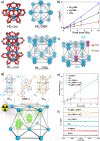Nanoscale Metal-Organic Frameworks Generate Reactive Oxygen Species for Cancer Therapy
- PMID: 32607433
- PMCID: PMC7318063
- DOI: 10.1021/acscentsci.0c00397
Nanoscale Metal-Organic Frameworks Generate Reactive Oxygen Species for Cancer Therapy
Abstract
In the past 15 years, enormous progress has been made in cancer nanotechnology, and a several nanoparticles have entered clinical testing for cancer treatment. Among these nanoparticles are nanoscale metal-organic frameworks (nMOFs), a class of organic-inorganic hybrid nanomaterials constructed from metal binding sites and bridging ligands, which have attracted significant attention for their ability to integrate porosity, crystallinity, compositional and structural tunability, multifunctionality, and biocompatibility into a singular nanomaterial for cancer therapies. This Outlook article summarizes the progress on the design of nMOFs as nanosensitizers for photodynamic therapy (PDT), radiotherapy (RT), radiotherapy-radiodynamic therapy (RT-RDT), and chemodynamic therapy (CDT) via nMOF-mediated reactive oxygen species (ROS) generated under external energy stimuli or in the presence of endogenous chemical triggers. Inflammatory responses induced by nMOF-mediated ROS generation activate tumor microenvironments to potentiate cancer immunotherapy, extending the local treatment effects of nMOF-based ROS therapy to distant tumors via abscopal effects. Future research directions in nMOF-mediated ROS therapies and the prospect of clinical applications of nMOFs as cancer therapeutics are also discussed.
Copyright © 2020 American Chemical Society.
Conflict of interest statement
The authors declare the following competing financial interest(s): W.L. is founder and chairman of Coordination Pharmaceuticals, Inc., which licensed the nMOF technologies from the University of Chicago.
Figures





References
Publication types
LinkOut - more resources
Full Text Sources
Miscellaneous

